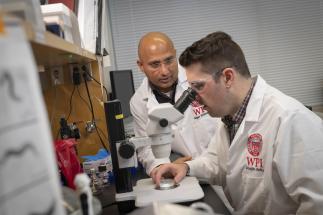Researchers at Worcester Polytechnic Institute (WPI) have developed a tool to identify molecular receptors in worms that are involved in sensing pheromones related to mating, an advance that could speed up neuroscience research into pheromones by eliminating months of work.

Associate professor of biology and biotechnology Jagan Srinivasan, doctoral candidate in biology Douglas K. Reilly, and researchers at Cornell University published their findings in Organic & Biomolecular Chemistry, a journal of the Royal Society of Chemistry in the United Kingdom.
Pheromones are chemicals produced by animals that send signals to other animals and trigger social responses, such as mating. Srinivasan and Reilly study pheromones in microscopic worms known as Caenorhabditis elegans, or C. elegans, to better understand how the sense of smell works. Their research could have implications for human research because C. elegans has a nervous system that mimics the basic mechanisms of smell in humans, and loss of the sense of smell is associated with neurodegenerative disorders such as Alzheimer’s disease.
Srinivasan and Reilly developed a process that more quickly isolates pheromone receptors in C. elegans. Receptors are specialized proteins that act as docking stations for molecules. When worms are exposed to pheromones, the pheromones latch onto the molecular receptors in the worms.





